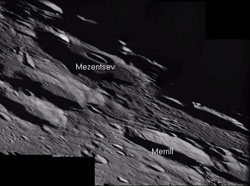An oblique look on the north lunar far west

“This cratered terrain is similar in topography to near-side highlands,” says SMART-1 Project scientist Bernard Foing, “while the far-side equator bulge can reach heights of 7 km, and the South Pole Aitken basin has depths down to 8 km”.
AMIE obtained this sequence on 16 May 2006. The imaged area is centred at a latitude of 73º North and a longitude of 124º West(or 34 º further than the West limb seen from Earth).
Normally, the SMART-1 spacecraft points the AMIE camera straight down, in the so-called Nadir pointing mode. In this image, AMIE was looking out 'the side window' and pointing towards the horizon, showing all craters in an oblique view. The largest craters shown are Mezentesev, Niepce and Merrill, located on the lunar far side, not visible from the Earth. Mezentsev is an eroded crater 89 kilometres in diameter, while Niepce and Merrill have the same size 57 km.
Mezentsev is named after Yourij Mezentsev, a Soviet engineer (1929 – 1965) who was one of the first people to design rocket launchers. Joseph Niepce was the French inventor of photography (1765 – 1833), while Paul Merrill was an American astronomer (1887 – 1961).
Media Contact
More Information:
http://www.esa.int/SPECIALS/SMART-1/SEM787BUQPE_0.htmlAll latest news from the category: Physics and Astronomy
This area deals with the fundamental laws and building blocks of nature and how they interact, the properties and the behavior of matter, and research into space and time and their structures.
innovations-report provides in-depth reports and articles on subjects such as astrophysics, laser technologies, nuclear, quantum, particle and solid-state physics, nanotechnologies, planetary research and findings (Mars, Venus) and developments related to the Hubble Telescope.
Newest articles

Properties of new materials for microchips
… can now be measured well. Reseachers of Delft University of Technology demonstrated measuring performance properties of ultrathin silicon membranes. Making ever smaller and more powerful chips requires new ultrathin…

Floating solar’s potential
… to support sustainable development by addressing climate, water, and energy goals holistically. A new study published this week in Nature Energy raises the potential for floating solar photovoltaics (FPV)…

Skyrmions move at record speeds
… a step towards the computing of the future. An international research team led by scientists from the CNRS1 has discovered that the magnetic nanobubbles2 known as skyrmions can be…





















